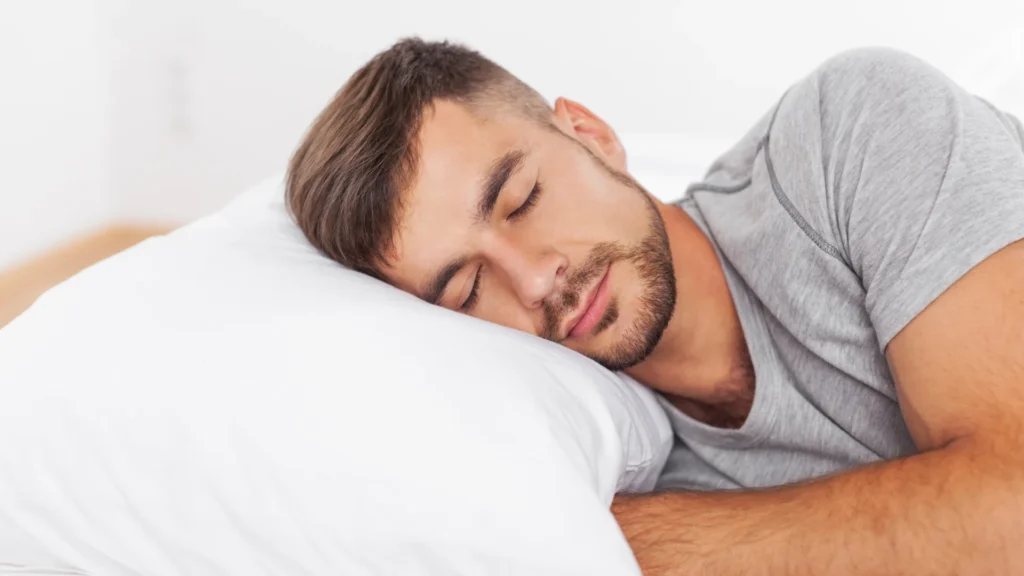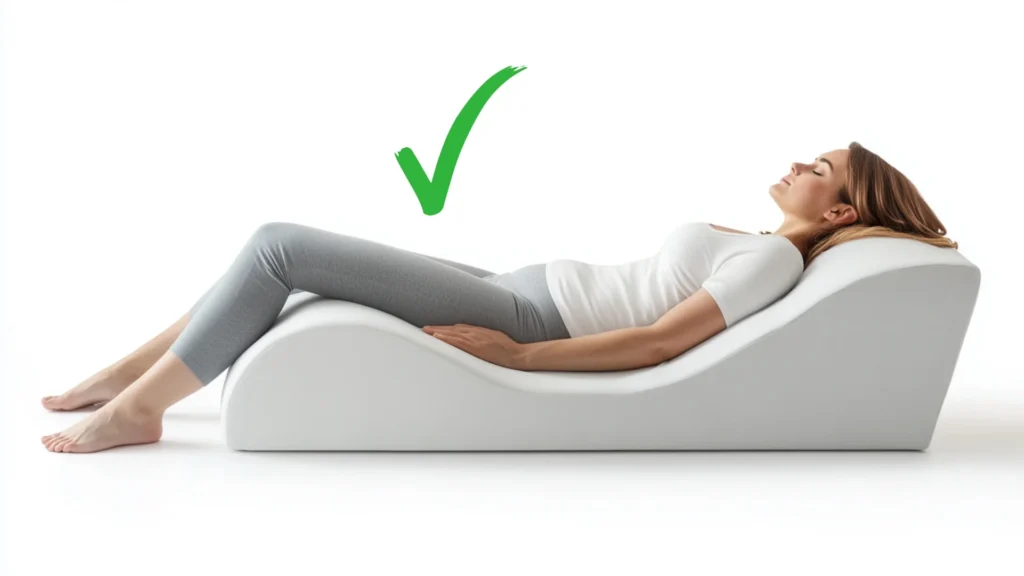Getting a good night’s sleep is crucial for our overall health, but for those with respiratory issues, it can be a challenge. The way we position ourselves during sleep can significantly impact our breathing and lung function. Finding the best sleeping position to clear lungs can make a world of difference in managing respiratory conditions and improving sleep quality.
Whether you’re dealing with chronic obstructive pulmonary disease (COPD), sleep apnea, or simply want to breathe easier at night, understanding how your sleep position affects your lungs is essential. In this article, we’ll explore various sleeping positions and their effects on lung health, helping you discover the most effective ways to clear your lungs and breathe easier while you sleep.
Side Sleeping

Side sleeping is widely regarded as the best sleeping position to clear lungs and improve overall respiratory function. This position allows for better drainage of mucus and reduces the risk of airway obstruction, making it particularly beneficial for those with respiratory conditions.
When you sleep on your side, gravity helps to keep your airways open and prevents the tongue and soft tissues in the throat from collapsing backwards. This can significantly reduce snoring and alleviate symptoms of sleep apnea. Additionally, side sleeping promotes better blood circulation and can help reduce acid reflux, which can sometimes contribute to breathing difficulties at night.
There’s an ongoing debate about whether the left or right side is better for sleeping. Some experts suggest that sleeping on the left side may be more beneficial as it can reduce heartburn and improve digestion. On the other hand, sleeping on the right side might be more comfortable for those with certain heart conditions. Ultimately, the choice between left and right side sleeping often comes down to personal comfort and any specific health concerns you may have.
To maximise the benefits of side sleeping, consider these tips:
- Use a pillow that keeps your head and neck aligned with your spine
- Place a small pillow between your knees to maintain proper hip alignment
- If you have shoulder pain, hug a pillow to your chest for added support
- Ensure your mattress provides adequate support to maintain proper spinal alignment
By adopting side sleeping as your preferred position, you can significantly improve your breathing quality and overall sleep experience. It’s an easy and effective way to support your lung health and wake up feeling more refreshed.
Elevated Head Position

Elevating your head while sleeping is another effective strategy in the quest for the best sleeping position to clear lungs. This position can significantly improve breathing and reduce congestion, making it particularly beneficial for those with respiratory issues or allergies.
When you elevate your head, gravity works in your favour by helping to drain mucus from your sinuses and chest. This can alleviate congestion and make breathing easier throughout the night. The elevated position also helps to reduce pressure on your diaphragm, allowing for fuller, deeper breaths.
There are several ways to achieve an elevated head position:
- Using extra pillows: Stack two or three pillows under your head and upper back to create a gentle incline.
- Wedge pillows: These specially designed pillows provide a stable, angled surface for your upper body.
- Adjustable beds: These allow you to easily raise the head of the bed to your preferred angle.
The ideal angle for elevation is typically between 30 to 45 degrees. This range provides the benefits of elevation without causing discomfort or strain on your neck and back. It’s important to find the right balance that works for you, as too steep an angle can lead to neck pain or sliding down during the night.
For those with acid reflux or GERD, elevating the head can also help prevent stomach acid from flowing back into the oesophagus, further contributing to easier breathing and better sleep quality.
By incorporating an elevated head position into your sleep routine, you can enhance your breathing, reduce congestion, and potentially improve your overall sleep quality. This simple adjustment can make a significant difference in your nightly respiratory health.
Other Beneficial Positions
While side sleeping and elevated head positions are often considered the best sleeping positions to clear lungs, there are other positions that can also offer respiratory benefits. These alternative positions may be particularly helpful for individuals with specific conditions or those who find the primary recommended positions uncomfortable.
Semi-Fowler’s Position

The Semi-Fowler’s position involves lying on your back with your upper body elevated at a 30 to 45-degree angle. This position can be achieved using an adjustable bed or by propping yourself up with pillows. The Semi-Fowler’s position offers several benefits:
- Reduces pressure on the lungs and diaphragm
- Helps prevent fluid accumulation in the lungs
- Eases breathing for people with heart conditions or respiratory issues
Prone Position

The prone position, or sleeping on your stomach, has gained attention for its potential benefits in severe respiratory conditions. While not typically recommended for regular sleep due to potential neck and back strain, it can be beneficial in specific medical situations:
- Improves oxygenation in severe respiratory distress
- Helps redistribute fluid in the lungs
- May be recommended for short periods under medical supervision
It’s important to note that the prone position should only be used under medical guidance, as it can be uncomfortable and may not be suitable for everyone.
Reclined Position
For some people, particularly those with sleep apnea or acid reflux, a reclined position can be beneficial. This involves sleeping in a recliner chair or using a wedge pillow to create a slight incline. The reclined position:
- Keeps airways more open than lying flat
- Reduces pressure on the diaphragm
- Can help with both breathing and digestive issues
While these positions can be helpful, it’s crucial to find what works best for your individual needs. Consulting with a healthcare professional can provide personalised advice on the best sleeping position to clear lungs based on your specific health conditions and concerns.
Positions to Avoid
While exploring the best sleeping position to clear lungs, it’s equally important to understand which positions can hinder your breathing and should be avoided. Two common sleeping positions that may negatively impact lung health are lying flat on your back and curling up in a tight position.
Lying Flat on Your Back
Sleeping flat on your back might seem natural, but it can pose several risks to your respiratory health:
- Airway obstruction: This position can cause your tongue to fall backwards, potentially blocking your throat. This is especially problematic for people with sleep apnea or other respiratory issues.
- Decreased lung function: When lying flat, your lungs don’t function as efficiently, leading to shallow breathing and reduced oxygen intake. This can significantly impact your sleep quality.
- Fluid accumulation: For some individuals, this position may increase the risk of fluid building up in the lungs, which can worsen breathing problems during sleep.
Curled-Up Positions

While curling up might feel cosy, it’s not ideal for lung health:
- Restricted lung expansion: Curled-up positions can make it difficult for your chest to fully rise during breathing, limiting your oxygen intake.
- Diaphragm pressure: This position can put unnecessary pressure on your diaphragm, resulting in shallow and ineffective breathing patterns.
- Increased discomfort: If you have respiratory issues, curling up can exacerbate feelings of breathlessness and discomfort during sleep.
By avoiding these positions and opting for the best sleeping position to clear lungs, such as side sleeping or elevating your head, you can significantly improve your respiratory health and overall sleep quality. Good sleep posture is crucial for maintaining proper respiratory function and ensuring adequate oxygen supply throughout the night.
Additional Tips for Clearing Lungs While Sleeping
While finding the best sleeping position to clear lungs is crucial, there are several additional strategies you can employ to enhance your respiratory health during sleep. These tips can complement your chosen sleeping position and further improve your breathing quality.
Use Supportive Pillows
Proper pillow placement can significantly enhance your chosen sleeping position:
- For side sleepers: Use a pillow that keeps your head aligned with your spine. Place another pillow between your knees to maintain proper hip alignment.
- For elevated positions: Use wedge pillows or stack multiple pillows to achieve the desired elevation without straining your neck.
Practice Breathing Exercises Before Bed
Engaging in breathing exercises before sleep can help clear your lungs and relax your respiratory muscles:
- Deep breathing: Take slow, deep breaths, focusing on fully expanding your lungs.
- Diaphragmatic breathing: Place one hand on your chest and the other on your belly. Breathe so that your belly rises more than your chest.
Create an Optimal Sleep Environment
Your bedroom environment can significantly impact your breathing during sleep:
- Keep the air clean: Use an air purifier to remove allergens and pollutants.
- Maintain proper humidity: Use a humidifier to keep the air moist, which can help prevent dryness in your airways.
- Control temperature: Keep your bedroom cool, ideally between 15-19°C (60-67°F), to promote better sleep and easier breathing.
Stay Hydrated
Drinking plenty of water throughout the day can help keep your airways clear:
- Aim for at least 8 glasses of water daily.
- Avoid excessive fluids right before bed to prevent nighttime bathroom trips.
Consider Using a CPAP Machine
For those with sleep apnea, a Continuous Positive Airway Pressure (CPAP) machine can be highly beneficial:
- Consult with your doctor about whether a CPAP machine is right for you.
- If prescribed, use it consistently for the best results.
By incorporating these additional tips alongside the best sleeping position to clear lungs, you can create a comprehensive approach to improving your respiratory health during sleep. Remember, consistency is key in developing healthy sleep habits.
Take Action for Better Breathing Tonight

Finding the best sleeping position to clear lungs can significantly improve your respiratory health and sleep quality. Side sleeping and elevated head positions offer the most benefits for most people. Experiment with these positions and use supportive pillows to find what works best for you.
Avoid lying flat on your back or curling up tightly, as these can hinder breathing. If you have specific health concerns, consult your doctor for personalised advice. Start implementing these changes tonight and pay attention to how you feel in the morning.
With consistent effort, you can enhance your breathing, reduce congestion and enjoy more restful sleep. Your lungs will thank you for making this simple yet effective change to your sleep routine.



